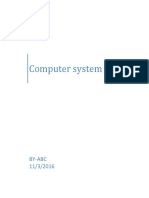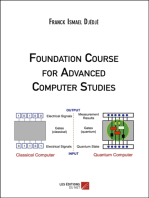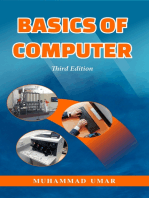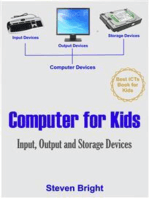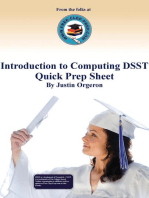Module2 Computer System
Uploaded by
Nik AinyModule2 Computer System
Uploaded by
Nik AinyKEMENTERIAN PELAJARAN MALAYSIA
Self Access Learning Module
ICT Literacy for Secondary School
Programme
Computer Hardware
Computer System
PUSAT PERKEMBANGAN KURIKULUM KEMENTERIAN PELAJARAN MALAYSIA
ICTL for Secondary School - Computer Hardware Module
MODULE 2
Overview of the Computer System
Curriculum Development Centre Ministry of Education Malaysia
ICTL for Secondary School - Computer Hardware Module
1.
Name of Module :
Computer Parts and Components Overview of the Computer System
2.
Learning Outcomes: The students should be able to: Identify main components in the computer system state the functions of the main components in the computer system explain briefly the data processing cycle of a computer system
3.
Knowledge and Skills: 1. What is a computer 2. The different types of computer
4.
Module Summary:
At the end of the module, students should be able to identify and
state the functions of the main components in the computer system as well as explain briefly the data processing cycle of a computer system.
This module contains 2 activities: Activity 1: Identifying the main components in the computer system and their functions Activity 2: Briefly explain the data processing cycle of the computer system
ICTL for Secondary School - Computer Hardware Module
Activity 1 MAIN COMPUTER SYSTEM
monitor system Unit speaker
keyboard
mouse
Monitor A monitor is a computer display that is like a TV monitor. A computer monitor image is made up of pixels (dots). In general, the higher the resolution, the better the image. The smaller the dots pitch (typically from 0.25 mm to 0.31 mm), the better the image. The different types of display screens are: Standard television set
An ordinary home televisionthat can be used for computer output.
Standard computer monitors
These monitors have better resolution than TV monitors. Some are flat screens.
Liquid Crystal Displays (LCD)
These screens are made up of two glass plates with liquid in between.
ICTL for Secondary School - Computer Hardware Module
Keyboard
Multimedia keyboard
Wireless keyboard
The keyboard is the main input device for text and commands. The computer keyboard uses the same key arrangement as typewriters. It also contain standard function keys, such as the escape, cursor movement and control keys.
Keyboards come with three (3) different types of port such as:
Serial port
PS/2 port
USB port.
ICTL for Secondary School - Computer Hardware Module
Speakers
Speakers give out information in the form of sound. Computer speakers range widely in quality and price. Computer speakers are typically packaged with computer systems in small plastic boxes with mediocre sound quality. The internal amplifiers requires an external power source, known as 'wall-wart'. Mouse
PS/2 port mouse A mouse is an input device used to controls the movement of the cursor or pointer on a display screen. It has right click, left click and double click to function
USB port optical mouse
Cordless optical mouse
An optical mouse uses camera technology and digital processing to compare and track the position of the mouse, rather than a ball and rollers used on PS/2 port mouse. A small LED (light-emitting diode) provides light underneath the mouse, helping to highlight slight differences in the surface underneath the mouse. It does not require maintenance or regular cleaning.
(source : http://images.search.yahoo.com)
ICTL for Secondary School - Computer Hardware Module
System Unit
A system unit is also known as a base unit. It is the main body of a desktop computer consisting of a metal or fibre enclosure containing the motherboard, power supply, cooling fans, internal disk drives, memory modules and expansion cards(such as video and network cards) that are plugged into the motherboard.
(source : http://en.wikipedia.org/wiki/System_unit)
Printer A printer is a device that produces a hard copy (permanent human readable text or graphics) of documents stored in electronic form that prints texts or illustrations on paper. Many printers are used as computer peripherals and are attached by a printer cable to a computer that serves as a document source. There are many types of computer printers. Dot-Matrix printer
The dot matrix printer is a low-cost printer that produces low quality output. It works like an automatic typewriter. It can also be used when carbon copies of a document are required.
ICTL for Secondary School - Computer Hardware Module
Ink-Jet printer
The ink jet printer is a low-cost printer that produces a mid-quality output. This type of printer is the most economical for colour output. Laser printer
The laser printer uses a laser beam to produce the best quality output. The speed of a laser printer is typically about 8 ppm (page per minute).
ICTL for Secondary School - Computer Hardware Module
Activity 2
Data Processing Cycle The computer system processes data into information through four operations; input, process, storage and output.
Input
Process
Output
Storage
The user enters the data by using an input device (such as keyboard, mouse) electronically and is processed by the processor. In the processing operation, data is manipulated to process or transform it into information
The storage (such as hard disk, compact disc (CD), diskettes) holds data, information and programs. The output devices (such as monitor, printer) present the processed data as useful information products to the user
ICTL for Secondary School - Computer Hardware Module
Activity 3 Task A Label the pictures below . Write your answers in the boxes given.
1.
2.
5.
3. 4.
ICTL for Secondary School - Computer Hardware Module
Task B
Look at the pictures given in Column A. Then, name the components of the computer and state their functions.
COLUMN A
COLUMN B (Component name and function)
10
ICTL for Secondary School - Computer Hardware Module
Task C
Complete the data processing cycle of a computer system below.
Input
11
ICTL for Secondary School - Computer Hardware Module
Reference Cashman, S. (2006) Discovering Computers 2006. USA : Thomson Course Technology. Ibrahim Ahmad, Mohd Hafiz et al (2007) Information and Communication Technology (ICT) Based on SPM Syllabus. Selangor: Venton Publishing (M) Sdn Bhd. NCC Education (2002) Computer Studies, Computer Ace. Sri Lanka : Computer Pioneers. Basic Computing (2003) by TMEdu Tech (M) Sdn Bhd http://www.wikipedia.org http://images.search.yahoo.com http://www.google.com.my
12
You might also like
- What Men Dont Want Women To Know - The Secrets, The Lies, The Unspoken Truth - Smith and Doe90% (20)What Men Dont Want Women To Know - The Secrets, The Lies, The Unspoken Truth - Smith and Doe157 pages
- Dangerous Google - Searching For Secrets PDF88% (26)Dangerous Google - Searching For Secrets PDF12 pages
- How To Download Documents From Scribd For Free - 7 Methods67% (9)How To Download Documents From Scribd For Free - 7 Methods25 pages
- Knowledge Matters Virtual Business Quiz Answers0% (2)Knowledge Matters Virtual Business Quiz Answers7 pages
- How To Disappear - Erase Your Digital Footprint, Leave False Trails, and Vanish Without A Trace PDF100% (3)How To Disappear - Erase Your Digital Footprint, Leave False Trails, and Vanish Without A Trace PDF111 pages
- 73L DI Turbo Diesel - 1997 - Engine Circuits Federal100% (3)73L DI Turbo Diesel - 1997 - Engine Circuits Federal3 pages
- Presentation 161 Content Document 20240930010554PMNo ratings yetPresentation 161 Content Document 20240930010554PM81 pages
- Presentation 141 Content Document 20240903023652PMNo ratings yetPresentation 141 Content Document 20240903023652PM34 pages
- Input and Output Devices of Computer With Examples, Chart 2No ratings yetInput and Output Devices of Computer With Examples, Chart 21 page
- Module 1 - Introduction To Digital DevicesNo ratings yetModule 1 - Introduction To Digital Devices14 pages
- ITWS R23 RECORD Notes Unit-1 and Unit-2No ratings yetITWS R23 RECORD Notes Unit-1 and Unit-225 pages
- The Computer System: Scope of The ModuleNo ratings yetThe Computer System: Scope of The Module35 pages
- I, II, III-COMPUTERS Remaining Syllabus NotesNo ratings yetI, II, III-COMPUTERS Remaining Syllabus Notes4 pages
- Set 4: Ictl Tingkatan 2: Instructions: Answer All The Following QuestionsNo ratings yetSet 4: Ictl Tingkatan 2: Instructions: Answer All The Following Questions5 pages
- Set 3: Ictl Tingkatan 2: This Question Consists of Part 1 and Part 2. You Must Answer All Questions Given BelowNo ratings yetSet 3: Ictl Tingkatan 2: This Question Consists of Part 1 and Part 2. You Must Answer All Questions Given Below4 pages
- 10 Useful Websites You Wish You Knew Earlier! 6 (2017)0% (1)10 Useful Websites You Wish You Knew Earlier! 6 (2017)21 pages
- HEALTH CARE POWER OF ATTORNEY (SC Statutory Form)No ratings yetHEALTH CARE POWER OF ATTORNEY (SC Statutory Form)7 pages
- Black & Decker The Complete Outdoor Builder100% (11)Black & Decker The Complete Outdoor Builder529 pages
- COMPUTER REPAIR Smartiepants - F - Ken Jaskulski83% (6)COMPUTER REPAIR Smartiepants - F - Ken Jaskulski330 pages




















































